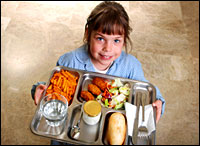As food prices rise, who gets hit first and hardest?

Clearly, urban dwellers in the global south, where people spend upwards of half of their incomes on food. According to the Wall Street Journal, here‘s the ever-growing list of nations that have experienced food-price riots:
Rioting in response to soaring food prices recently has broken out in Egypt, Cameroon, Ivory Coast, Senegal, and Ethiopia. In Pakistan and Thailand, army troops have been deployed to deter food theft from fields and warehouses. World Bank President Robert Zoellick warned in a recent speech that 33 countries are at risk of social upheaval because of rising food prices. Those could include Indonesia, Yemen, Ghana, Uzbekistan, and the Philippines.
And don’t forget Haiti, where the prime minister recently resigned "after a week in which that tiny country’s capital was racked by rioting over higher prices for staples like rice and beans." Five people died in that unrest.
But you don’t have to look across oceans to find effects of the food-price crunch. Try asking your kid. In public schools, cafeteria administrators have a dollar a day to spend on ingredients for every kid’s lunch, after paying for overhead and labor.
So when food prices jump, compromises get made. From a great story in Monday’s Washington Post:
Sharp rises in the cost of milk, grain, and fresh fruits and vegetables are hitting cafeterias across the country, forcing cash-strapped schools to raise prices or pinch pennies by serving more economical dishes. Some school officials on a mission to help fight childhood obesity say it’s becoming harder to fill students’ plates with healthy, low-fat foods.
For example, you’re seeing stuff like this:
Small, rural districts, which don’t serve enough meals to court competitive bids from suppliers, might be squeezed the most. The 12 schools in Davie County used to offer fresh fruit three or four times a week. Now it’s twice weekly. To boost snack revenue, the schools returned a full-fat cookie to the snack line.
And this:
And in Davie County, N.C., Yoo-hoo drinks, which had been taken off the shelf in favor of healthier options, are back. Sure, officials would rather the kids chugged milk. But each Yoo-hoo sale brings in 36 cents of profit.
Higher food prices hit vulnerable populations first and hardest. Here in the United States, land of perhaps the industrialized world’s most brutal and miserly school-lunch system, that group includes public-school children.

